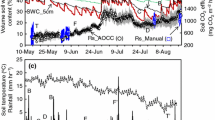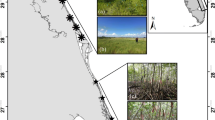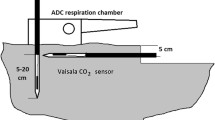Abstract
CO2 efflux rates are affected by vegetation type, temperature, and soil surface conditions, and serve as an indicator of the length of the below-ground biological and microbial growing season. This study determined the effect of three land-use treatments on CO2 efflux and growing season lengths in Southeast Virginia on two forested mineral soil wetlands. CO2 efflux, soil temperature, and soil moisture were measured 24 times in 18 months at plots representing forest, early successional field, and bare ground land-use treatments. CO2 efflux differed (p < 0.05) by treatment in the order forest > field > bare ground. CO2 efflux was higher in hardwood- than conifer-dominated forest and higher in bare ground plots that were not inundated. Appreciable CO2 efflux took place even once leaves had fallen off deciduous trees, and most of the CO2 efflux appeared to be from vegetation rather than microbial sources during that period. Variability in CO2 efflux was best described by the interaction between soil temperature and soil moisture (R2 = 0.32) (p < 0.05). The below-ground growing season indicated by appreciable CO2 efflux was similar to that indicated by soil temperatures above 5°C measured at 50 cm, the regulatory reference depth. The CO2 efflux growing season was 365 days in the forest but was 9–16 days shorter in the field and 21–78 days shorter in the bare ground land-use treatment plots. These data can be used to modify the regulatory growing season definition in forested thermic wetlands and to reflect the environmental variation caused by different land uses.
Similar content being viewed by others
References
M.M. Brinson (1993) A Hydrogeomorphic Classification for Wetlands Wetlands Res. Prog. Tech. Rep. WRP-DE-4. USACE Waterways Exp. Stn. Vicksburg MS, USA
Burdt A.C. 2003. Hydric soil properties as influenced by land use in Southeast Virginia wet flats. M.S. Thesis. Virginia Polytechnic Institute and State University, Blacksburg, VAUSA.
F.P. Day SuffixJr. J.P. Megonigal (1993) ArticleTitleThe relationship between variable hydroperiodproduction allocation, and belowground organic turnover in forested wetlands Wetlands 13 115–121
Domanski G., Kuzyakov Y. and Stahr K. 2001. Evaluation differentiation of soil sources contributed to the CO2 emission from soil Inst. Soil Sci. and Land.Univ. of HohenheimD-70593 StuttgartGermany. Avaialable at: www.uni-hohenheim.de/~wwwgkoll/teilpr/grzegorz/grzegorze.html Last verified Sept. 27, 2004.
InstitutionalAuthorNameEnvironmental Laboratory. (1987) Corps of Engineers wetland delineation manual Tech. Rep. Y–87–1, USACE Waterways Exp. Sta Vicksburg, MS, USA
R.W. Griffin L.P. Wilding W.L. Miller G.W. Crenwelge R.J. Tucker L.R. Drees W.C. Lynn (1996) Preliminary investigations of hydric soil hydrology and morphology on the Texas Gulf Coast Prairie J.S. Wakeley S.W. Sprecher W.C. Lynn (Eds) Preliminary Investigations of Hydric Soil Hydrology and Morphology in the United States Tech.Rep. WRP-DE-13. U.S.Army Engr. Waterways Exp. Station Vicksburg, MS, USA 9–30
P.M. Groffman A.J. Gold R.C. Simmons (1992) ArticleTitleNitrate dynamics in riparian forests: Microbial studies J. Environ. Quality 21 666–671
P.J. Hanson N.T. Edwards C.T. Garten J.A. Andrews (2000) ArticleTitleSeparating root and soil microbial contributions to soil respiration: A review of methods and observations Biogeochemistry 48 115–146 Occurrence Handle10.1023/A:1006244819642 Occurrence Handle1:CAS:528:DC%2BD3cXitVOjsrg%3D
D.M. Howard P.J. Howard (1993) ArticleTitleRelationships between CO2 evolution, moisture contentand temperature for a range of soil types Soil Biol. Biochem. 25 1537–1546
Y. Ino M. Monsi (1969) ArticleTitleAn experimental approach to the calculation of CO2 amount evolved from several soils J. Jap. Bot. 20 153–188 Occurrence Handle1:CAS:528:DyaF1MXlt1aqsbc%3D
K. Inubushi Y. Furukawa A. Hadi E. Purnomo H. Tsuruta (2003) ArticleTitleSeasonal changes of CO2CH4N2O fluxes in relation to land-use change in tropical peatlands located in coastal area of South Kalimantan Chemosphere 52 603–608 Occurrence Handle10.1016/S0045-6535(03)00242-X Occurrence Handle1:CAS:528:DC%2BD3sXjsVGnsr0%3D Occurrence Handle12738298
M.U.F. Kirshbaum (2002) ArticleTitleWill changes in soil organic carbon act as a positive or negative feedback on global warming? Biogeochemistry 48 21–51
M. Lane (1998) Conservation of black bear habitat on private land in the Great Dismal Swamp ecosystem R.K. Rose (Eds) The Natural History of the Great Dismal Swamp Omni Press Madison, WI, USA 209–226
M.F. Laporte L.C. Duchesne S. Wetzel (2002) ArticleTitleEffect of rainfall patterns on soil surface CO2 efflux, soil moisturesoil temperature and plant growth in a grassland ecosystem of northern OntarioCanada: implications for climate change BMC Ecol. 2 10 Occurrence Handle10.1186/1472-6785-2-10 Occurrence Handle12445327
W.F. Lichtler P.N. Walker (1979) Hydrology of the Dismal Swamp, Virginia–North Carolina P.W. Kirk SuffixJr. (Eds) The Great Dismal Swamp The Univ. Press VA CharlottesvilleVAUSA 140–168
C.L. Mallows (1973) ArticleTitleSome comments on C.P Technometrics 15 661–675
J.P. Megonigal S.P. Faulkner W.H. Patrick (1996) ArticleTitleThe microbial activity season in southeastern hydric soils Soil Sci. Soc. Am. J. 60 1263–1266 Occurrence Handle1:CAS:528:DyaK28Xktl2qtrk%3D
T.R. Moore M. Dalva (1997) ArticleTitleMethane and carbon dioxide exchange potentials of peat soils in aerobic and anaerobic laboratory incubations Soil Biol. Biochem. 29 1157–1164 Occurrence Handle10.1016/S0038-0717(97)00037-0 Occurrence Handle1:CAS:528:DyaK2sXksFChurs%3D
Neter J., Kutner M.H., Nachtsheim C.J. and Wasserman W. 1996. Applied Linear Statistical Models. 4th ed. Times Mirror Higher Educ. Group & Irwin, ChicagoIL.
NOAA-NCDC. 2003. County weather data [Online]. Available at http://www.ncdc.noaa.gov/oa/ncdc.html (verified 15 Mar. 2003).
R.E. Pangle J. Seiler (2002) ArticleTitleInfluence of seedling roots, environmental factors and soil characteristics on soil CO2 efflux rates in a 2-year-old loblolly pine (Pinus taeda L.) plantation in the Virginia Piedmont Environ. Pollut. 116 S85–S96 Occurrence Handle10.1016/S0269-7491(01)00261-5 Occurrence Handle1:CAS:528:DC%2BD38XhsFer Occurrence Handle11833922
E.A. Paul F.E. Clark (1989) Soil Microbiology and Biochemistry Acad. Press San DiegoCAUSA
E. Pendall S. Bridgham P.J. Hanson B. Hungate D.W. Kicklighter D.W. Johnson B.E. Law Y. Luo J.P. Megonigal M. Olsrud M.G. Ryan S. Wan (2004) ArticleTitleBelow-ground process responses to elevated CO2 temperature: a discussion of observations, measurement methods, and models New Phytol. 162 311–322
E.W. Pickering P.L.M. Veneman (1984) ArticleTitleMoisture regimes and morphological characteristics in a hydrosequence in Central Massachusetts Soil Sci. Soc. Am. J. 48 113–118
S.A. Prior D.C. Reicosky D.W. Reeves G.B. Runion R.L. Raper (2000) ArticleTitleResidue and tillage effects on planting-implement induced short-term CO2 and water loss from a loamy sand soil in Alabama Soil Tillage Res. 54 IssueID3/4 197–199
J.W. Raich A. Tufekciogul (2000) ArticleTitleVegetation and soil respiration: correlations and controls Biogeochemistry 48 71–90 Occurrence Handle10.1023/A:1006112000616 Occurrence Handle1:CAS:528:DC%2BD3cXitVOjsro%3D
E.J. Reber M.A. Bailey P.J. Swecker J.S. Quesenberry D. Bradshaw (1981) Soil survey of City of Suffolk Virginia. USDA-NRCS. U.S. Govt. Print. Office Washington, D.C
Reth S., Göckede M. and Falge E. 2003. Temperature and Soil Water Controls on CO2 Efflux from Agricultural Soils. Geophysical Research Abstracts. Vol. 5, 01061. European Geophysical Society, LindauGermany.
W.H. Schlesinger (1977) ArticleTitleCarbon balance in terrestrial detritus Annu. Rev. Ecol. Syst. 8 51–81 Occurrence Handle10.1146/annurev.es.08.110177.000411 Occurrence Handle1:CAS:528:DyaE1cXlt1Cl
Snedecor G.W. and Cochran W.G. 1989. Statistical Methods. 8th ed. Iowa State Univ. Press, Ames, IAUSA.
InstitutionalAuthorNameSoil Survey Staff (1996) Soil survey laboratory methods manual. Soil Survey Investigations Report No.42., Ver. 3.0. U.S. Gov. Print. OfficeWashington D.C., USA.
Soil Survey Staff 1999. Soil Taxonomy: A Basic System of Soil Classification for Making and Interpreting Soil Surveys. 2nd ed. Agric. Handb. No. 436. U.S. Gov. Print. OfficeWashington, D.C., USA.
USDA-SCS 1981. Land Resource Regions and Major Land Resource Areas in the United States. Agric. Handb. 296. U.S. Print. OfficeWashington, D.C., USA.
InstitutionalAuthorNameUSDA-SCS (1985) National Food Security Act Manual U.S. Gov. Print. Office Washington, D.C., USA
R. Wagai K.R. Brye S.T. Gower J.M. Norman L.G. Bundy (1998) ArticleTitleLand use and environmental factors influencing soil surface CO2 flux and microbial biomass in natural and managed ecosystems in Southern Wisconsin Soil Biol. Biochem. 30 1501–1509 Occurrence Handle10.1016/S0038-0717(98)00041-8 Occurrence Handle1:CAS:528:DyaK1cXkvV2isrw%3D
B. Widen A. Lindroth (2003) ArticleTitleA calibration system for soil carbon dioxide-efflux measurement chambers: description and application Soil Sci. Soc. Am. J. 67 327–334 Occurrence Handle1:CAS:528:DC%2BD3sXnvFSgsA%3D%3D
R.E. Wildung T.R. Garland R.L. Buschbom (1975) ArticleTitleThe interdependent effect of soil temperature and water content on soil respiration rate and plant root decomposition in arid grassland soils Soil Biol. Biochem. 7 373– 378 Occurrence Handle10.1016/0038-0717(75)90052-8 Occurrence Handle1:CAS:528:DyaE28XhtlClsrc%3D
A.E. Williams (1992) Clarification and interpretation of the 1987 manual. USACE-CECE-OR memorandum USACE Waterways Exp. Stn. Vicksburg, MS USA
Author information
Authors and Affiliations
Corresponding author
Rights and permissions
About this article
Cite this article
Burdt, A.C., Galbraith, J.M. & Megonigal, J.P. Using CO2 Efflux Rates to Indicate Below-Ground Growing Seasons by Land-use Treatment. Wetlands Ecol Manage 14, 133–145 (2006). https://doi.org/10.1007/s11273-005-5461-8
Received:
Accepted:
Issue Date:
DOI: https://doi.org/10.1007/s11273-005-5461-8




